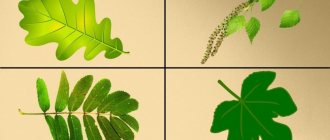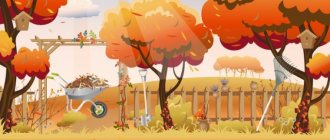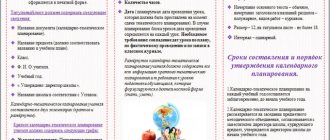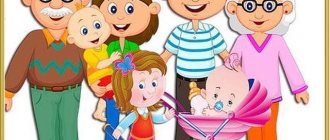Thematic planning in the middle group. Topic of the week: “Gifts from old Lesovik”
Morning.DI. "Let's help Fedora"
Task:
To teach to understand the essence of the concepts: “funny”, “pity”, “to be happy for another”; evoke a desire to be neat. Help Fedora. (N.F. Gubanova “Development of gaming activities” p. 141).
Conversation: “The sky in autumn”
Goal: To be able to notice autumn changes in the sky. Introduce children to the concept of “clouds” and “clouds”.
Articulation gymnastics. Finger gymnastics. Morning exercises.
P/I" "Don't lose the ball" (throwing)
1 GCD Drawing
Topic: “Brave Cockerel”
(drawing based on presentation).
Program content:
Teach children to draw a cockerel with gouache paints, beautifully combining shapes and colors.
Improve your brush technique: move the brush freely and confidently along the pile, repeating the general outline of the silhouette.
Develop observation, sense of color and shape.
Cultivate an interest in reflecting your ideas in the world around you in visual arts.
Literature: Lykova, p.34.
2 GCD FEMP
The first 4 lessons can be devoted to repeating and consolidating the material covered. Lesson 5 Goal. Teach children to distinguish between sets of 1 and 2, 2 and 3 objects based on a one-to-one comparison of their elements; name the total number of items based on the teacher’s count; determine, based on visual comparison, which number is greater and which is less, using appropriate terms; consolidate the ability to identify sides on yourself (right, left arm, leg, shoulder, etc.). Demonstration material: typesetting canvas, 3 squirrels, 3 bunnies and 3 carrots (color images). Handout: on the tables there are 2 vases with flags: for each child 2 blue and 2 red flags (the sticks of the flags are of different thicknesses).. Progress of the lesson. Part 1. 1 bunny is placed on the top strip of the typesetting cloth, and 1 squirrel is placed on the bottom strip. (The squirrel is exactly under the bunny.) The teacher finds out how many squirrels and bunnies there are, then adds 1 more squirrel and says that children will learn not only to distinguish which objects are more and which are fewer, but also to say how many there are, and she will count herself . “How many bunnies? How many squirrels? 1, 2,” the teacher believes, “only 2 squirrels.” With intonation he highlights the total of the count and circles the squirrels with his hand. “Look who has more: bunnies or squirrels? How many squirrels? Who is less? How many bunnies? Children show extra squirrel. The teacher summarizes the children’s answers: “There are 2 squirrels - there are more of them, and there are 1 bunny, there are fewer bunnies than squirrels.” Then he adds a bunny. Finds out how many there are. The teacher counts the bunnies, and then asks: “Are there equal numbers of squirrels and bunnies?” How many squirrels and bunnies? Checks whether the children answered correctly and recounts both groups again. Children name the number of squirrels and bunnies. Then the teacher removes 1 squirrel and finds out how many are left. “How many bunnies? Who is more (less)? Which number is greater (smaller): 1 or 2?” In a similar way, the teacher can compare the number of bunnies and carrots: “Are there enough carrots for the bunnies? How many are there?” Etc. Part 2 (physical education minute). The teacher invites the children to stand up and put their hands down. With your right hand, touch your right ear, with your left hand, touch your left ear; touch your right knee with your right hand, touch your left knee with your left; touch your right shoulder with your right hand, touch your left shoulder with your left hand. Part 3 (work with handouts). The teacher invites the children to show their right hand, left hand. Take 1 blue flag in your left hand, and 2 red flags in your right hand. He asks: “Which flags did you take more? How many are there? Which ones are smaller? How many are there?” Then invites the children to take 1 more blue flag. He asks how many flags there are now of each color. Next, first place a red and then a blue flag in the vase. Each time the number of flags is compared. After the children have 1 blue and 1 red flag left, the teacher asks which flag has a thicker (thinner) stick, and offers to place first a flag on a thin stick and then a flag on a thick stick in the vase.
LiveInternetLiveInternet
Quote from Tatyana57
Read in full In your quotation book or community!
SPEECH DEVELOPMENT. LEXICAL TOPIC “TREES AND SHRUBS”.
CHILDREN SHOULD KNOW THE NOUNS: rosehip, currant, raspberry, barberry, hawthorn, thorns, lumps, clusters, berries, aspen, rowan, linden, apple tree, spruce, pine, birch, buds, branches, trunk, leaves, fruits, seeds, earrings , crown, top, bark, roots, cones. ADJECTIVES: white-trunked, slender, tall, low, elegant, beautiful, large, carved, birch, spruce, rustling, rough, branched, evergreen, spreading, small, green, yellow, red, prickly, smooth, round, oblong, sweet, sour, ripe, bitter, hard, soft, juicy, healthy, medicinal. VERBS: prickly, grow, stand, sway, fall, ripen, sway, pick, collect, bloom, decorate, fly, crumble, make noise, plant, tremble, water, fertilize, protect. CHILDREN SHOULD BE ABLE TO FORM ADJECTIVES FROM NOUNS: Birch - birch. Spruce - spruce. Rowan - rowan. Pine - pine. Aspen - aspen. Currant - currant. Linden - lime. Apple tree - apple tree. CHILDREN SHOULD BE ABLE TO DESCRIBE TREES (SHRUBS) BY QUESTIONS: What is the name of this tree? Tree or shrub? How big is it? Where does it most often grow? What parts does it consist of? What kind of tree trunk does it have? (thick, thin, tall, short...) What kind of bark does the tree have? (dark, light, smooth, rough...) What shape are the leaves? (round, oval, carved, elongated, needles...). How can it benefit people? How does it change at different times of the year? What can be made from this tree? Why do people plant trees on city streets? TO DISTINGUISH A TREE FROM A BUSH BY SIGNS: An adult tree is taller than a bush. The tree has one trunk.
A STORY ABOUT THE BIRCH. This is a birch tree. She has a white, thin, slender trunk. The branches have round leaves. The birch tree feeds with the help of its roots. Birch is a large deciduous tree. Most often it grows in the forest. In the city, people plant birch trees to make the air clean. Various crafts are made from birch bark. In spring, buds appear on the birch tree and turn into leaves. The birch tree remains green all summer. In autumn the leaves turn yellow and fall off. In winter, bare branches are covered with snow.
All plants can be divided into three groups: trees, shrubs and herbs. Trees are the largest and longest-living representatives of living nature. They are as tall as a ten-story building. The tree consists of three main parts. The roots hold it in the ground and absorb water and mineral salts from the soil. The trunk and branches carry the sap and lift the leaves towards the sun. The tree becomes taller and wider due to the growth of shoots and branches at the top. The trunks of all trees are covered with bark, which protects the delicate interior of the tree from drying out and various damage.
Trees are deciduous and coniferous. Deciduous trees shed their leaves in the fall and the leaves appear again in the spring. Deciduous trees include willow, linden, maple, oak, birch, and poplar.
Coniferous trees have long thin needles instead of leaves, which are called needles, and they do not shed them in the fall, but remain with the needles all year round. In spring, coniferous trees, along with old needles, produce new young needles. That's why coniferous trees are always green. Coniferous trees include fir, spruce, and pine.
Shrubs are similar to small trees, but differ from them in that they do not have one thick trunk, like a tree, but several thin trunks connected together at the base. WHAT ARE TREES FOR, THE BENEFITS OF TREES: Trees purify and moisten the air, create coolness, and some produce delicious edible fruits. Sawn wood is a building material: dried trunks are used to make boards, plywood, furniture, toys, and paper. Trees grow slowly, so they need to be protected. We need to protect the trees, take care of them, sometimes talk to them kindly, and in the spring, plant young trees together with our parents. CONVERSATION ON QUESTIONS: What trees do you know? (deciduous and coniferous). Where do trees grow? What types of forests are there? (If pine and spruce trees grow in the forest, then this forest is coniferous. If oaks and aspens grow in the forest, then this forest is deciduous. If spruce, birch and oak trees grow in the forest, then this forest is mixed. If birch trees grow in the grove, then this is a birch grove. If oaks grow in the grove, then it is an oak grove. If maples grow in the grove, then this is a maple grove.) Why are they called that? What does the tree have? (Root, trunk, branches, leaves (needles), crown, fruits.) Are trees different from shrubs? How? Are trees living or non-living? Who (or what) helps them grow? GAME “WHOSE FRUITS?” Acorns grow on... oak; clusters of rowan grow on - rowan; apples grow on an apple tree; catkins grow on birch, alder; round cone on a pine tree; long cone on - spruce. Etc. GAME “NAME IT AFTERLY.” Spruce - Christmas tree. Pine - pine. Birch - birch. Needle - needle. Branch - twig. A lump is a lump. GAME "GUESS WHICH TREE I'M TALKING ABOUT?" Slender, curly, white-trunked... (birch) Sad, sad, weeping... (willow) Slender, green, prickly... (spruce) Strong, mighty, spreading... (oak). READING A STORY. There was a spruce tree growing near the house. There were cones on the spruce tree. Lena was collecting cones in a bag. Lena gave the cones to her mother. Mom made toys out of cones. CONVERSATION ON QUESTIONS. Where did the spruce grow? What did mom make from the pine cones? What kind of toys could you make from pine cones? RETELLING OF THE RIDDLE ABOUT TREES: It makes you happy in the spring, It cools you in the summer, It nourishes you in the fall, It warms you in winter. (Tree) The bee takes the most delicious honey from my flower. But they still offend me: They tear off my thin skin. (Linden tree) I have longer needles than a Christmas tree. I grow in height very straight. If I'm not at the edge, the branches are only at the top. (Pine) Like pines, like fir trees, And in winter without needles. (Larch) Turned green in spring, tanned in summer, wore red corals in autumn. (Rowan) A Russian beauty stands in a clearing, wearing a green blouse and a white sundress. (Birch) She lowered her curls into the river and became sad about something, but what she is sad about doesn’t tell anyone. (Willow) You will find her in the forest, Let's go for a walk and meet her. Stands prickly like a hedgehog, In winter in a summer dress. (Spruce) In summer - snow! Just laughter! Snow is flying around the city, why doesn't it melt? (Pople fluff) No one is scared, but everyone is trembling. (Aspen)
Series of messages “Speech Development”:
Part 1 - POSTER. BERRIES. Part 2 - SPEECH DEVELOPMENT. LEXICAL TOPIC “POWERIES”. ... Part 12 - SPEECH DEVELOPMENT. LEXICAL TOPIC “GIFTS OF AUTUMN”. Part 13 - SPEECH DEVELOPMENT. LEXICAL TOPIC "BERRIES". Part 14 - SPEECH DEVELOPMENT. LEXICAL TOPIC “TREES AND SHRUBS”. Part 15 - SPEECH DEVELOPMENT. RIDDLES ABOUT BERRIES. Part 16 - SPEECH DEVELOPMENT. RUSSIAN FOLK TALE “MASHA AND THE BEAR”. HOME THEATER. Part 17 - SPEECH DEVELOPMENT. RIDDLES ABOUT VEGETABLES. Part 18 - SPEECH DEVELOPMENT. RIDDLES ABOUT FRUIT.





